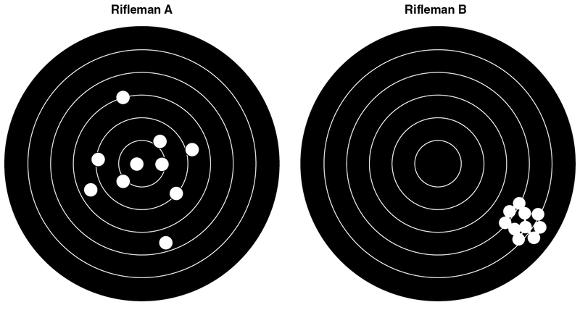Using constant error and variable error
This is an excerpt from Motor Control and Learning 6th Edition With Web Resource by Richard A. Schmidt,Timothy D. Lee,Carolee Winstein,Gabriele Wulf,Howard N. Zelaznik.
An additional aspect of error scores is important from the point of view not only of research but also of practical application. Compare two riflemen: Rifleman A has a large VE and small CE, whereas rifleman B has a small VE and large CE. This situation was described years ago by Chapanis (1951) and is illustrated in figure 2.4 (see "The Relative Importance of Constant and Variable Errors"). Which riflemanman, A or B, appears to be the more skilled?
The study of motor learning will show that the measure of error that is most sensitive to the effects of practice is consistency (VE); bias (CE) often changes quickly in the first several trials and remains near zero thereafter, even after years of practice. There are some situations, however, in which CE is preferred to VE; but these are specialized applications. Thus, these two measures of error, CE and VE, seem to represent two distinct aspects of performance - bias and variability, respectively. But sometimes it is more desirable to have a single measure of "overall error" that combines both of these performance indicators rather than using separate measures of accuracy and inconsistency.
The Relative Importance of Constant and Variable Errors
Research Capsule
Alphonse Chapanis was one of the pioneers in the emergence of human factors research. His analysis of errors in movement is as important today as it was over a half century ago.
"Having defined constant and variable errors, we might ask: Which is the more important? Let us return for a moment to the target patterns shot by the two riflemen [figure 2.4]. At first glance, you might say that B is a very inaccurate shooter. And yet any rifleman will tell you that this is not the case at all. B is a much better shooter than A. The reason is this: The large constant error in the trial shots fired by B can be compensated for very easily by simple adjustments in his sights. With suitable corrections in elevation and windage, rifleman B will turn in a perfect score. In rifle shooting, then, constant errors are not the important ones, because they can be very easily adjusted for by changing the position of the sights on the gun. The really important errors are the variable errors. No correction of the sights on A's gun will make all of his shots fall in the center. He is inherently much too variable." (Chapanis, 1951, p. 1187)

Figure 2.4 Distribution of rifle shots. Rifleman A has a small constant error (CE) and large variable error (VE). Rifleman B has a large CE bias, but a small VE.
Reprinted, by permission, from A. Chapanis, 1951, "Theory and methods for analyzing errors in man-machine systems," Annals of the New York Academy of Sciences 51: 1181.
Learn more about Motor Control and Learning, Sixth Edition With Web Resource.
More Excerpts From Motor Control and Learning 6th Edition With Web ResourceSHOP

Get the latest insights with regular newsletters, plus periodic product information and special insider offers.
JOIN NOW
Latest Posts
- Big problem verses small problem activity
- Combining creativity with a structured framework to create fun and effective games
- Designing games to allow all students to experience success
- Examples of TR sensory stimulation activities
- Therapeutic recreation tools of the trade
- The four steps in the therapeutic recreation process


